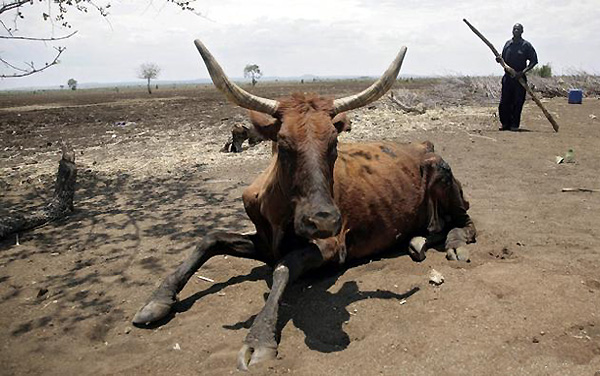 Climate change is a silent slow motion video that with a touch on your remote bursts out of your TV with the cacophony of earthquakes and volcanic thunder. You reach for the remote. Mute the volume again. Change the channel.
Climate change is a silent slow motion video that with a touch on your remote bursts out of your TV with the cacophony of earthquakes and volcanic thunder. You reach for the remote. Mute the volume again. Change the channel.
Half of Zimbabwe’s population is starving. Today. Right now. Kenya’s oil that had been saving its government from default has come to an abrupt halt. “Unprecedented numbers” are starving and sick in southern Africa.
This is Remote Climate Change: Too much cold and rain in East Africa. Too much hot and drought in southern Africa. You know the story, and now you don’t want to hear it, again.
“As things stand, we will run out of food by end of February, ” said Niels Balzer, WFP’s Deputy Country Director in Zimbabwe. WFP requested $293 million for Zimbabwe but has secured less than 30 percent.
Drought has cyclically effected sub-Saharan Africa throughout my life time. It came about every ten years. The historical record is a laboratory of what it can cause, beyond the drought, itself.
Today, Zimbabwe is the most unstable country in all of sub-Saharan Africa, despite its wealth – some argue because of it. Rich with natural resources, bordered by a grand river that powers the area’s largest hydroelectric dam and originally blessed with excellent soil and sustainable forests, Zimbabwe was the place to invest when I was in my 20s. And this despite the fact its politics were a mess even then.
But with each drought the frailties in the society, its politics, got worse.
“A dire shortage of foreign currency, runaway inflation, rising unemployment, lack of fuel, prolonged power outages and large-scale livestock losses are worsening the crisis in the country,” the Centre for African Journalism reports, today.
If it weren’t for South Africa’s continuous bailout of the country the entire country would have collapsed ten years ago.
One of Mandela’s lauded additions to South Africa’s constitution allows unhindered immigration into the country from anywhere else in Africa.
For the last 20 years South Africans have so feared Zimbabwe Collapse that they just keep throwing tons of money and food and medicines at it to stave the refugee catastrophe.
“Climate Change” is an euphemism for too rapidly changing climate, unnaturally rapid, extreme events one after the other. So the droughts in southern Africa began to accelerate about 25 years ago, and started to arrive every 7-8 years.
Then every 5 years.
And now lasting for more than a year each time. The current one heading into its third year.
And then when they break it’s not definitively so as it used to be. By standard geological metrics the area is rapidly becoming a wasteland.
Weak societies like Zimbabwe are already self-destructing. Climate refugees join the political and economic refugees and the numbers mount. Already South Africa is beset by xenophobic violence throughout the country. Undoubtedly their constitution will change, but everyone knows walls and guns and tanks won’t stop refugees.
And South Africa is only one country below Zimbabwe. The northern part of South Africa is also in drought, and as climate change progresses distressed areas will enlarge southwards.
South Africa is the strongest, most stable country in the region. But is it stronger or more stable than Florida or Texas or California?
Long before matters of life and death threaten all Americans they will threaten South Africans… and Indians and Argentinians. Those of us who can’t unshackle morality will feel obligations to help them with our own dwindling resources.
This is climate change.